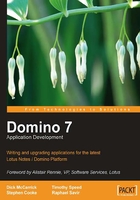
Domino Administrator
There are several significant new features and improvements with release 7 of the Domino Administrator client. These new features will help administrators with configuration, maintenance, and uptime. One of the most important new features is Domino Domain Monitoring (DDM). Chapter 11 has a section dedicated to this new powerful feature. Other features/tools include administration event script handling (via LotusScript).
Policy administration has been enhanced. This includes the ability to lock down end-user desktops, and a new Mail policy.
Domino 7 provides integration with Tivoli Autonomic Monitoring Engine (TAME). This provides event reporting capabilities to other Tivoli Interfaces (for example, Tivoli Enterprise Console). Domino resource modules, built for Domino TAME, can report CPU‑, memory‑, disk‑, and network‑utilization statistics. The resource modules are configured with DDM interfaces and report to Tivoli Enterprise Console.
The improved activity trends feature uses these Domino server features:
- Activity logging to collect information used for resource balancing.
- Activity trends to set up times for data collection and retention.
- Domino Change Manager to implement a workflow process in which changes made to the system are controlled and approved.
Enhancements to Smart Upgrade include the ability to detach kits in the background, to prevent time lost to a non-working client; and failover from a shared (network) upgrade kit to another server's attached kit. If clustered, Smart Upgrade uses a cluster mate if the first server is unavailable. Smart Upgrade also helps prevent excessive server load by limiting the number of downloads from a single server. Also, it provides notification to administrators, via a mail-in database, of the Smart Upgrade status by user/machine (Success, Failed, or Delayed). In addition, you can provision the Smart Upgrade Tracking database.
DB2 Management tools let you enable Domino to run with a DB2 data store, configure a connection document from DB2 Access for a Domino server to Domino, and allow DB2 usernames/passwords to be added to server IDs. You also have enhanced support in status and statistics panels indicating DB2 usage and statistics plus other visual cues. (See Chapter 3 for more on the new DB2 integration features offered in Notes/Domino 7.)
- The ability to write status bar history to a log file.
- The ability to suppress the Roaming User Upgrade prompt.
- Domino Web Administrator support for Mozilla browsers.
- Three new event‑notification methods, which are programmable via LotusScript, batch language, Java, C, and so on.
- An enhanced Message ID feature that allows a message ID to be prefixed to console messages, via the
notes.inisettingsDisplay_MessageID=1andDisplay_MessageSeverity=1.
The administration process will no longer revert name changes automatically, but will require that the administrator either approve or reject the name change reversion.